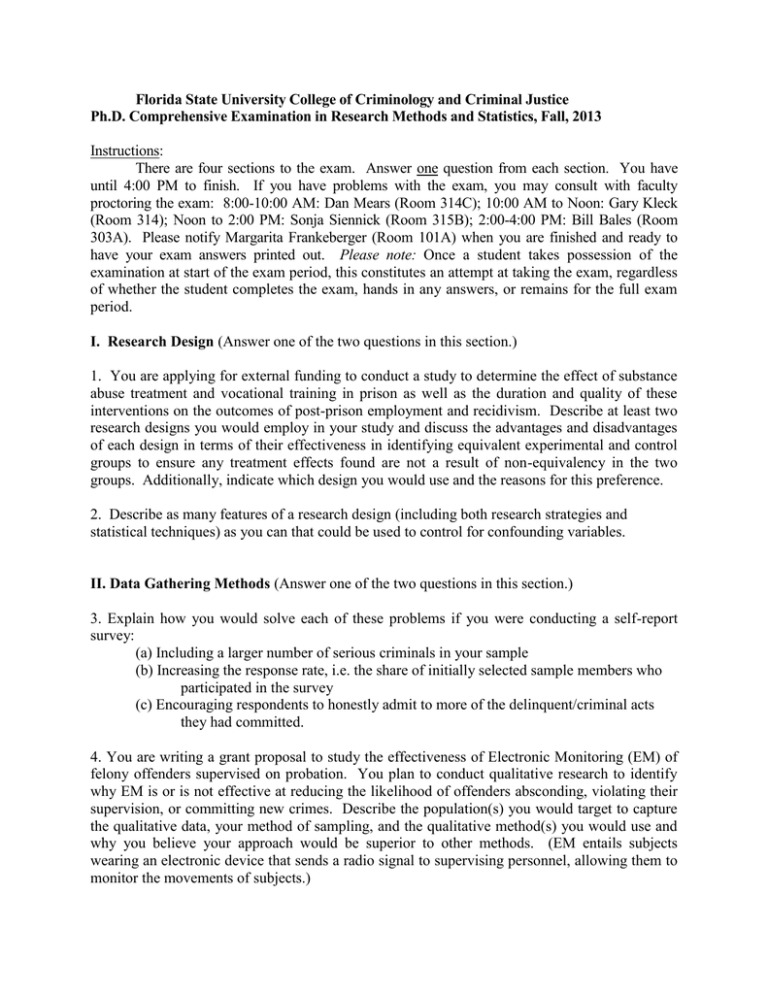Methods Fall 2013
advertisement

Florida State University College of Criminology and Criminal Justice Ph.D. Comprehensive Examination in Research Methods and Statistics, Fall, 2013 Instructions: There are four sections to the exam. Answer one question from each section. You have until 4:00 PM to finish. If you have problems with the exam, you may consult with faculty proctoring the exam: 8:00-10:00 AM: Dan Mears (Room 314C); 10:00 AM to Noon: Gary Kleck (Room 314); Noon to 2:00 PM: Sonja Siennick (Room 315B); 2:00-4:00 PM: Bill Bales (Room 303A). Please notify Margarita Frankeberger (Room 101A) when you are finished and ready to have your exam answers printed out. Please note: Once a student takes possession of the examination at start of the exam period, this constitutes an attempt at taking the exam, regardless of whether the student completes the exam, hands in any answers, or remains for the full exam period. I. Research Design (Answer one of the two questions in this section.) 1. You are applying for external funding to conduct a study to determine the effect of substance abuse treatment and vocational training in prison as well as the duration and quality of these interventions on the outcomes of post-prison employment and recidivism. Describe at least two research designs you would employ in your study and discuss the advantages and disadvantages of each design in terms of their effectiveness in identifying equivalent experimental and control groups to ensure any treatment effects found are not a result of non-equivalency in the two groups. Additionally, indicate which design you would use and the reasons for this preference. 2. Describe as many features of a research design (including both research strategies and statistical techniques) as you can that could be used to control for confounding variables. II. Data Gathering Methods (Answer one of the two questions in this section.) 3. Explain how you would solve each of these problems if you were conducting a self-report survey: (a) Including a larger number of serious criminals in your sample (b) Increasing the response rate, i.e. the share of initially selected sample members who participated in the survey (c) Encouraging respondents to honestly admit to more of the delinquent/criminal acts they had committed. 4. You are writing a grant proposal to study the effectiveness of Electronic Monitoring (EM) of felony offenders supervised on probation. You plan to conduct qualitative research to identify why EM is or is not effective at reducing the likelihood of offenders absconding, violating their supervision, or committing new crimes. Describe the population(s) you would target to capture the qualitative data, your method of sampling, and the qualitative method(s) you would use and why you believe your approach would be superior to other methods. (EM entails subjects wearing an electronic device that sends a radio signal to supervising personnel, allowing them to monitor the movements of subjects.) 2 III. Statistics (Answer one of the two questions in this section.) 5. Describe at least three different types of nonlinear relationships and how you would model the relationships statistically. In each instance, describe how the nonlinearity may be relevant to modifying a theory or developing a policy. 6. (a) Define multicollinearity (b) State why it creates problems for data analysis, and (c) Describe the ways an analyst can deal with the issue IV. Data Interpretation (Answer one of the two questions in this section.) 7. Interpret the findings of the attached article by Mears et al. This means that you should tell what the results mean with respect to the goals of the researchers and what they were trying to find out, just as if you were writing the Results and Discussion/Conclusion sections of the journal article. Do not merely repeat in words what is already shown in numbers in the tables. What conclusions would follow from the results? What problems with the methods might undermine or weaken these conclusions? 8. Interpret the findings of the attached article by Pickett et al. This means that you should tell what the results mean with respect to the goals of the researchers and what they were trying to find out, just as if you were writing the Results and Discussion/Conclusion sections of the journal article. Do not merely repeat in words what is already shown in numbers in the tables. What conclusions would follow from the results? What problems with the methods might undermine or weaken these conclusions?



